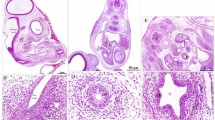Summary
The avian stomach is subdivided into two parts, the proventriculus and the gizzard. It has been shown that the gizzard epithelium can express embryonic chick pepsinogen (ECPg) antigen, a marker protein of the proventricular epithelium, as well as normal proventricular epithelium, under the appropriate experimental conditions. To study the possible mechanisms involved in the suppression of ECPg synthesis in the gizzard epithelium during normal development, we carried out heterotypic and heterochronic recombination experiments of the epithelium and mesenchyme of these two organ rudiments. When recombined and cultured with 6-day proventricular mesenchyme, gizzard epithelium of 3.5- to 12-day embryos expressed pepsinogen at all stages tested. However, the ratio of ECPg-positive cells to total epithelial cells in the gizzard epithelium decreased rapidly when epithelium older than 7 days was cultured with proventricular mesenchyme. In contrast to proventricular mesenchyme, 6-day gizzard mesenchyme did not allow ECPg expression in associated proventricular epithelium of 3.5- to 7-day embryos. These results indicate that gizzard epithelium does not express pepsinogen in normal development because of both a decrease in ability to express the enzyme in itself in the course of development and a repressive influence of gizzard mesenchyme.
Similar content being viewed by others
References
Anson ML (1939) The estimation of pepsin, trypsin, papain and cathepsin with hemoglobin. J Gen Physiol 22:79–89
Caplan AI, Ordahl CP (1978) Irreversible gene repression model for control of development. Science 201:120–130
Dawid D (1972) Les relations épithélio-mésenchymateuses au cours de l'organogenèse gastrique du foetus de Lapin. J Embryol Exp Morphol 27:177–197
Finch RA, Zwilling E (1971) Culture stability of morphogenetic properties of chick limb-bud mesoderm. J Exp Zool 176:397–408
Furihata C, Kawachi T, Sugimura T (1972) Premature induction of pepsinogen in developing rat gastric mucosa by hormones. Biochem Biophys Res Commun 47:705–711
Gumpel-Pinot M, Yasugi S, Mizuno T (1978) Différenciation d'épithéliums endodermiques associés au mésoderme splanchnique. CR Acad Sci (Paris) 286:117–120
Gurdon JB (1987) Embryonic induction — molecular prospects. Development 99:285–306
Haffen K, Kedinger M, Simon-Assmann PM, Lacroix B (1982) Mesenchyme-dependent differentiation of intestinal brush-border enzymes in the gizzard endoderm of the chick embryo. In: Burger MM, Weber R (eds) Embryonic development, part B. Cellular aspects. AR Liss, New York, pp 261–270
Hamburger V, Hamilton HL (1951) A series of normal stages in the development of the chick embryo. J Morphol 88:49–92
Ishizuya-Oka A, Mizuno T (1984) Intestinal cytodifferentiation in vitro of chick stomach endoderm induced by the duodenal mesenchyme. J Embryol Exp Morphol 82:163–176
Ishizuya-Oka A, Mizuno T (1985) Chronological analysis of the intestinalization of chick stomach endoderm induced in vitro by duodenal mesenchyme. Wilhelm Roux's Arch 194:301–305
Le Douarin N (1969) Particularités du noyau interphasique chez la Caille japonaise (Coturnix coturnix japonica.) Utilisation de ces particularités comme “marquage biologique” dans des recherches sur les interactions tissulaires et les migrations cellulaires au cours de l'ontogenèse. Bull Biol Fr Belg 103:435–452
Lowry OH, Rosebrough NJ, Farr AL, Randall RJ (1951) Protein measurement with the Folin phenol reagent. J Biol Chem 193:265–275
Masui T (1981) Differentiation of the yolk-sac endoderm under the influence of the digestive-tract mesenchyme. J Embryol Exp Morphol 62:277–289
Mizuno T, Yasugi S (1973) Différenciation in vitro de l'épithélium de l'allantoïde associé à différents mésenchymes du tractus digestif, chez l'embryon de Poulet. CR Acad Sci (Paris) 276:1609–1611
Mizuno T, Yasugi S, Takiguchi K (1986) Formation de glandes et expression de pepsinogène dans l'endoderme du gésier sous l'influence du mésenchyme proventriculaire chez l'embryon de Poulet. CR Séances Soc Biol 180:113–116
Samloff IM, Townes PL (1970) Electrophoretic heterogeneity and relationships of pepsinogens in human urine, serum, and gastric mucosa. Gastroenterology 58:462–469
Sawyer RH, Fallon JF (1983) Epithelial-mesenchymal interactions in development. Praeger, New York
Sigot M (1971) Organogenèse de l'estomac de l'embryon de Poulet. Analyse des mécanismes de la différenciation. Arch Anat Microsc Morphol Exp 60:169–204
Sigot M, Marin L (1970) Organogenèse de l'estomac de l'embryon de Poulet. Evolution de l'épithélium du proventricule au contact de surfaces conditionnées par des mésenchymes. J Embryol Exp Morphol 24:43–63
Takiguchi K, Yasugi S, Mizuno T (1986) Gizzard epithelium of chick embryos can express embryonic pepsinogen antigen, a marker protein of proventriculus. Wilhelm Roux's Arch 195:475–483
Wessells NK (1977) Tissue interactions and development. Benjamin, California
Wolff Et, Haffen K (1952) Sur une méthode de culture d'organes embryonnaires “in vitro”. Tex Rep Biol Med 10:463–472
Yasugi S (1979) Chronological changes in the inductive ability of the mesenchyme of the digestive organs in avian embryos. Dev Growth Differ 21:343–348
Yasugi S (1984) Differentiation of allantoic endoderm implanted into the presumptive digestive area in avian embryos. A study with organ-specific antigens. J Embryol Exp Morphol 80:137–153
Yasugi S, Mizuno T (1978) Differentiation of the digestive tract epithelium under the influence of the heterologous mesenchyme of the digestive tract in the bird embryos. Dev Growth Differ 20:261–267
Yasugi S, Mizuno T (1981) Purification and characterization of embryonic chicken pepsinogen, a unique pepsinogen with large molecular weight. J Biochem 89:311:315
Yasugi S, Mizuno T (1982) L'expression de protéases acides et sa régulation dans le proventricule embryonnaire d'Oiseaux. CR Séances Soc Biol 176:880–884
Yasugi S, Mizuno T (1984) Différenciation hétérotypique de l'hypoblaste d'Oiseau sous l'influence du mesenchyme proventriculaire. CR Séances Soc Biol 178:580–583
Yasugi S, Matsushita S, Mizuno T (1985) Gland formation induced in the allantoic and small-intestinal endoderm by the proventricular mesenchyme is not coupled with pepsinogen expression. Differentiation 30:47–52
Author information
Authors and Affiliations
Rights and permissions
About this article
Cite this article
Takiguchi, K., Yasugi, S. & Mizuno, T. Developmental changes in the ability to express embryonic pepsinogen in the stomach epithelia of chick embryos. Roux's Arch Dev Biol 197, 56–62 (1988). https://doi.org/10.1007/BF00376042
Received:
Accepted:
Issue Date:
DOI: https://doi.org/10.1007/BF00376042




